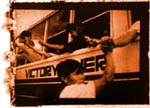
Keeping it Real
Written by Michele Meek | Posted by: Anonymous
RI Filmmaker Shawn Hainsworth’s documentary won the "Outstanding Resourcefulness Award," which is appropriate for someone who spent six years and traveled to three countries to make a movie. But that’s only the making of it–and what is certainly most notable about his work "Between Worlds" is the final result. It is an honestly and beautifully told story of three Amerasian families who take the leap between worlds from Vietnam to the United States. Allowing the "plot" to be shaped by his subjects, Hainsworth is able to do what few documentarians do–draw out a moving story, inspiring characters, all the more amazing because it is told simply and sincerely.
ML: So, as you know I really enjoyed your film. I am always amazed by filmmakers who take on a project for many years, like you did. What inspired you in the first place, and then what inspired you to keep going during the 5-year (or more?) making of "Between Worlds"?
HAINSWORTH: I think one of the most important aspects of this kind of documentary is that you (the filmmaker) are not in control of what will happen to the participants, and the worst thing you can do is to try and exercise control, make things happen, artificially construct a story through editing, or set an arbitrary time limit for your shooting schedule. When I decided to make this film, I knew that it would take a long time for the refugees to build new lives for themselves in America, and for their stories to have enough of an arc to really represent the depth and complexity of their experiences. I imagined I would shoot for about five years and it ended up being closer to six years. There came a point, about four years in, when I thought, "These stories are never really going to come together," and I started to think about how I could leverage the footage that I had differently. But, then, within a 6 or 7 month period of time in 1997, things happened in the lives of all three characters that created a natural climax.
The actual editing took place over about a six month period of time. The other thing I should mention is that I worked on other projects while I was shooting this film. I completed another documentary in 1996 entitled "Sunflowers." Gathering footage over six or seven years requires more patience than time. I probably only spent about 4-5 weeks a year shooting throughout five of those six years, excluding the six months I lived in the refugee camp in the beginning, and the six months of editing in the end. So, I had plenty of time to do other things. You just try not to get caught up in anything external that would force you to finish the film early.
You know, there came a time in 1994 & 95 when Vietnam was starting to heat up as subject matter. 20/20 did a piece on an Amerasian child. Diplomatic relations between the two countries were normalized. There were a lot of articles about Vietnam in the newspaper, and a lot more tourists began to explore Vietnam. And, I began to think, I need to get my film out so I can take advantage of this media interest. And in all honesty, my film was released in the same year as several other films about Vietnam so there was a lot more competition for distribution. Perhaps the film would have done a little better if I had finished it a year or two earlier. It’s hard to say. I try not to get caught up in that kind of thinking and just stay focused on the material.
ML: To me, the most significant aspect of your documentary is how the stories are moved by the people in the film, and I never feel as if I’m being "taught a lesson," etc. Tell me a bit of how you were able to achieve this style?
HAINSWORTH: I think this "style" mostly comes primarily from my attitude towards the process. I have no desire to teach a lesson or even to try to represent the big picture of refugee resettlement. I just wanted to present these three stories as honestly as possible. I feel that if you reduce your subject matter to a moral or a political point of view, or anything that can be articulated in some way other than by watching the film, then you are losing the real depth and potential power of your subject matter. This attitude permeates every aspect of the production since I do everything myself (camera work, editing, writing, etc.)
I am working on a new film now where I am following some high school students in Oakland, California. And people keep asking me what it will be about. What are the larger issues? What do I hope to find in the material? It is always awkward, but the only answer I can give is that I don’t know. I’ll find out as time passes and as the participants open up more and more, and as things happen in their lives. But, I would never start a film thinking this is what it will be about. I start a film saying, it will be interesting to follow these people and see what happens. I also don’t pick characters because I think this is what will happen to them. I try not to have any preconceived ideas about the people in the film or what might happen to them.
ML: I know you mentioned at the New England Film and Video Festival screening that your film was picked up for educational distribution. Tell me about this process – how did you find a distributor? What types of films do they represent? What did you learn from the whole process?
HAINSWORTH: Actually, deciding on an educational distributor was easy. UC Berkeley Extension Center for Media and Independent Learning distributes my other documentary, "Sunflowers." I like the people at UC and thought they were doing a good job with "Sunflowers," so I submitted ["Between Worlds"] to them with the idea that if they accepted it, I would just go with them.
I spent a lot more time trying to decide on a distributor for "Sunflowers." I took it to the IFFM in New York, and attended Content (the market side of the National Educational Media Network where "Sunflowers" won a Bronze Apple). I also talked to other filmmakers and sent out a lot of tapes. UC had a good reputation, and I just liked their representatives when I talked to them at Content. There are really not that many good, solid educational distributors out there, and they will all review pretty much anything, so you just have to do your homework and lick a bunch of stamps. I find being listed in the IFFM catalog has really helped. That is how I found the television distributor for "Between Worlds."
My strategy for the IFFM is to get in and attend my screening, but otherwise not to spend any money on press kits or flyers, etc. Most distributors look through the catalog carefully and will contact you if your work seems appropriate. You also get a list of "buyers" when you attend IFFM and that is a good way to find people you think might be appropriate. If you are focusing on the educational market, then I would attend definitely attend Content in addition to the IFFM. The most difficult aspect of the whole thing is always the contract. You need to learn how to read them, and get some advice from an entertainment attorney the first time out. A lot of first-time filmmakers view getting an offer as the final step. But, you need to view getting a distributor as a long-term business relationship. The offer is just the beginning of your negotiations. The contract is the basis for your relationship, so you need to know what is involved.
I prefer to have a different distributor for different markets. I want my educational distributor just doing educational sales, and my television distributor just working on television sales. There are some one stop shopping distributors that will cover all markets, but I just feel like there’s no way they are going to push your film in each separate market as they would if that was their only focus.
ML: What do you think of most documentaries that you see – on television, in the theater? How do they inform you of what you do/don’t want to do as a filmmaker?
HAINSWORTH: I am amazed at the number of really good documentaries that are produced every year. I am just frustrated because it is so hard to see them. The distribution system for documentary film is very limited. I really believe there are a lot of people out there who want to see this kind of work and would support it if they knew it was there. I think public television actually has a strong negative impact on the perception and distribution of documentary film. By restricting the style of documentaries to the typical narrator-driven, historical film which is personified by public television productions, and by severely limiting access to other forms of documentaries, the public associates documentary with one (in my opinion, very limited) form.
POV and ITVS and other organizations and stations do a lot to diversify programming on PBS, and there are a few cable stations that support other kinds of documentaries, but it is just not enough. Most people believe that their documentary needs are being served by PBS, and they just don’t realize that a whole other world exists. I know a lot of people who are big supporters of PBS. But, within this group of my acquaintances, I have yet to meet someone who is not a filmmaker who has heard of POV.
To answer your question on a more personal note, I love to see other people’s work. It always informs and improves my own work, which is why it is so frustrating to be someone who seeks out this kind of work and often can not get access to it.
ML: It has always seemed to me that there is a struggle for the documentarian to remain true to the people’s story and yet create a film that is "dramatic" for viewers. How do you resolve this struggle in your films?
HAINSWORTH: I think this is one of the most important questions for a documentary filmmaker. We all know how greatly we reduce the complexity of the people’s lives we are representing. We also know that we will always, inherently, add some sort of structure to the material, be it a dramatic arc or otherwise. Even Fred Wiseman’s films are very structured. I think the best you can do is to try to represent things as honestly as possible. This means throwing away material that is not honest and resisting the urge to build a strong dramatic structure rather than portray events as they happened. Watching a Wiseman film, you can feel the integrity despite the reduction and structure.
Personally, I have a lot of work-in-progress screenings to keep myself as honest as possible (especially since I edit my own work and get so close to it I can’t see it anymore). My biggest problem is representing people negatively. It is very hard to take someone who has opened their life to you and then put things on film that are going to hurt them or make them feel betrayed. In "Between Worlds," there was one character who had been physically threatened not to discuss the abuse she received from another character in the film. In the end, I felt like I couldn’t put her in that position and so left out the details of his abuse while intimating what had happened. I feel pretty good about it, because most people pick up that something bad went down in the way this girl was treated, but the details are missing and so she feels safer.
ML: I don’t know if this was intentional or not, but your film does show the amazing opportunities that people have in this country compared with theirs–was that intentional and how do you feel about that portrayal?
HAINSWORTH: It was not intentional. Like I said, I try not to have any agenda while making a film. In a way, this film is perhaps harmed a little in the long run by the fact that each of these characters was pretty successful, not in terms of their careers necessarily, but in terms of what they got out of the resettlement process as a whole. It does make it seem like that there is a message to the film, or at least a point of view. But, you know, you can’t know what will happen to people when you pick them. I did not pick people who I thought would be successful, it just happened that way. Perhaps it would be better if one of the characters was really unsuccessful, but you know, you just can’t structure it on that level unless you are making a fiction film.
ML: What is your next project?
HAINSWORTH: As I mentioned above, I am working on a film about high school students in Oakland High. I am also making a small, experimental film about religion. Personally, I wanted to explore digital effects more and get away from the rigors of non-manipulation imposed by my other documentaries. Not that one can’t manipulate documentaries and make great films, but it has not been my style to date.
ML: Are there any plans for "Between Worlds" to play at other festivals or on television?
HAINSWORTH: To date, it has played at about ten film festivals. I am in a little bit of a bind with the television end of it. KQED, the PBS station in San Francisco, wants to air the show, but since I signed with a television distributor and KQED isn’t offering much money, I have to wait for the distributor to finish his work before I can negotiate something on my own with KQED or any other station. POV and HBO passed on the film, so I’ll just have to wait and hope my distributor finds a good venue on US television.
ML: Can people buy a copy of "Between Worlds" and how much does it cost?
HAINSWORTH: Unfortunately, at this point I cannot sell home video copies. My contract with UC Berkeley says that I won’t enter into home video sales until two years have expired on their contract. I can sell a couple of copies at festivals under the terms of a personal appearance, but otherwise it is not for sale.
ML: Well readers, take my word for it. It’s worth the wait…
Copies of Shawn Hainsworth's earlier films 'Heavens Gate' and 'Coyote Tales' can be purchased at BuyIndies.com.











